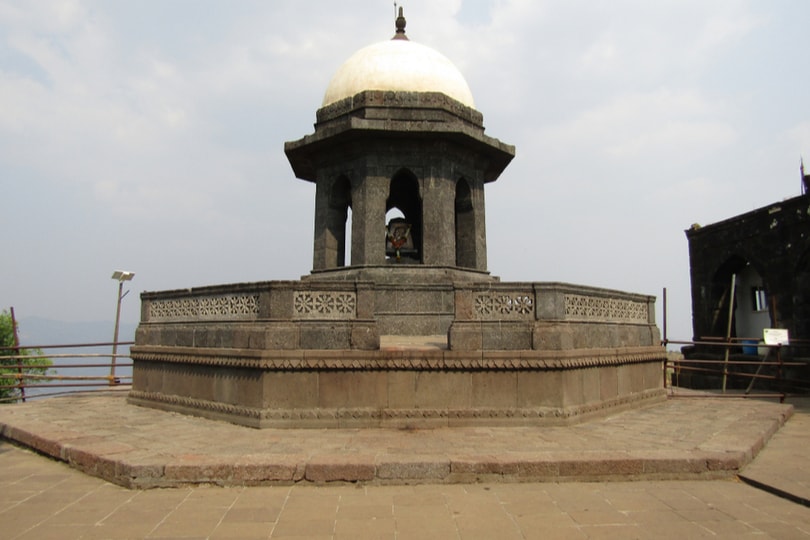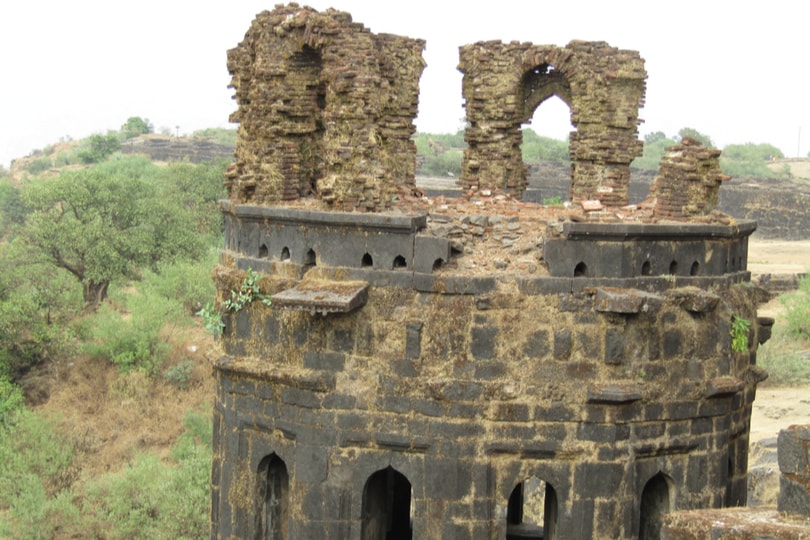

Known as the “Gibraltar of the East” by the Europeans, the Raigad Fort is a majestic and aesthetically appealing hill fort in the district of Raigad, Maharashtra. Located 820 meters above sea level in the Sahyadri mountain range, the fort can be accessed by a single pathway comprising of 1737 steps. Its strategic build speaks of the clever architecture and design used centuries ago. Surrounded by deep green valleys, the fort has several gateways that enthrall its visitors, namely, the Mena Darwaja, Nagarkhana Darwaja, Palkhi Darwaja, and the majestic Maha Darwaja which is the main entrance to the imperial structure. Today, the fort serves as a living reminder of the glory and valor of the Marathas.


Back in the year 1656, the distinguished Maratha ruler, Chatrapati Shivaji Maharaj, seized the fort of Rairi from Rajchandraji More, Ruler of Jawali, and built his capital city. He expanded and renovated the fort and renamed it “Raigad.” Located at the base of the fort, the villages of Pachad and Raigadwadi had a very crucial role to play in defense of the royal house. It is said that cavalry of ten thousand men was always kept on standby in Pachad during the rule of the Marathas. Apart from its strategic location of being cut off from the Western Ghats, the Raigad Fort was heavily fortified to keep swarming enemies at bay.
In 1689, Mughal invaders defeated the Marathas and took control over the fort, which was later renamed to “Islamgad” by Aurangzeb. The 1700s witnessed the rise of British East India Company in India, who saw the fort as a stronghold and hence, carried out an armed expedition against the same. In 1818, the British bombarded and destroyed the legacy of the Marathas and took control over the remains.
Despite being in ruins at present, the fort still entails a majestic ambience that will make you feel its grandness and splendor dating back to 1030 AD.
The Chit Darwaja is located at the foothills of the fort near the village of Pachad. It is from here that visitors start on their foot journey to the Khoob Ladha Buruj, and then to the Maha Darwaja, the main entrance to the fort. Built centuries ago, the massive entrance to the fort reflects the pride and glory of the Marathas. If you find the climb of 1737 steps too demanding, you can also avail ropeway facilities that will take you directly to the top of the fort near Mena Darwaja leading to the Rani Vasa. You can also find the office complex of the king’s secretaries towards the right of the Mena Darwaja.
If you are visiting the fort for the first time, do not miss exploring the chambers of the queen or the Rani Vasa that comprises of six chambers each with attached restrooms. These chambers were used by the mother of Shiv Chhatrapati along with the other royal ladies and are some of the only structures standing intact.
Just in front of the queen chambers is the Palkhi Darwaja that served as a special doorway for Shivaji Maharaj’s convoy. To the right of this doorway are three dark chambers that are believed to be the granaries of the fort by historians.
The main palace of Shivaji, Raj Bhavan, was made out of wood; however, it is only the bases of the pillars that remain. Home to the royal Marathas, the Raj Bhavan has witnessed victories, anger, joys and sorrows along with Shivaji Chhatrapati’s overwhelming generosity.
The Raj Bhavan leads to a massive, sprawling lawn also known as the Raj Sabha. This open ground has witnessed various important events of the Maratha rule. From the splendor of battle wins to the coronation of Shiv Chhtrapati, the Raj Sabha has seen it all. This is also where Shivaji Maharaj broke the shackles of slavery that lasted for over 300 years and established Hindavi Swarajya. The king’s throne was a magnificent masterpiece studded with precious jewels such as diamonds and pearls and rested on a column of 1000 kilograms of pure gold.
The impressive drainage system of the Royal Bath speaks for the architectural excellence prevalent centuries ago. You will be amazed to know that it leads to an underground cellar that was used for secretive activities back in the day such as worshipping Bhavani Mata, storing loot from wars, secret dialogues and what not!
The fort is also home to the remains of three watchtowers that once guarded this enormous structure. Two of the three towers still remain while the British attack destroyed the third.
Take a walk at the Holi Cha Mal just outside the Nagarkhana Darwaja during your first visit to Raigad Fort. This massive open ground was used by the people of the fort to celebrate Holi in early days. Today, it is an excellent spot to explore with your family and friends. The Bara Tanki comprised of more than a dozen water reservoirs and its ruins will amaze you by their magnificent structure.
The Hirakani Buruj is a famous wall in the premises of Raigad fort that stands strong even today. Constructed over a high cliff, this wall has an interesting story attached to it. According to local folklore, a woman named Hirakani belonging to a nearby village had come to Raigad to sell milk at the fort. However, she was trapped inside the fort when the gates of the wall were locked after sunset. Hearing the echoes of her little son crying from the adjacent village, an anxious Hirkani couldn’t wait for the gates to reopen the next morning and courageously climbed the steep cliff during the pitch dark hours of the night. Shivaji was amazed to hear this feat and built the Hirakani Buruj in appreciation of her bravery.
The Takmak Tok is a massive rock cliff located at a height of 1200 feet. The breathtaking view of the enchanting valleys of Sahyadri hills make it a popular tourist spot of Raigad. According to local legends, the Takmak Tok used to be a punishment point where wrongdoers were pushed off to death. It is also believed that Shivaji Maharaj punished a number of enemies and traitors by sending them hurtling down this valley.
While you are at the fort, visit Shivaji’s tomb. The ruins of an ancient marketplace can be found in the premises of the fort with a statue of Shivaji right in front of it.
A strong believer in Hinduism, Shivaji Maharaj built the Jagadishwar temple as an act of devotion to Lord Jagadishwar. Located 25 km away from Mahad, it is believed that Shivaji used to visit the temple everyday. If you are looking for a serene, spiritual retreat, explore the temple grounds that house idols of Jagadishwar and Nandi.
Located in Pachad, the Gangasagar Lake is a massive artificial lake that is believed to be built during the coronation of Shivaji Maharaj. A major tourist spot, the lake lies in front of the fort against a scenic backdrop of snow clad peaks. Visit the lake if you are looking for a quiet getaway amidst nature.
Explore the Jijamata Palace and pay your respects to the lady behind the success and greatness of Shivaji Maharaj. Dedicated to the mother of the great ruler, this palace is a must visit if you want to dig deep into history and unravel tales of the Maratha empire. Mostly destroyed by the British Army, the palace is now protected by the Archaeological Survey of India (ASI).
If you are a history buff, visit the Raigad Museum situated on the lower floors of Raigad Fort to peruse paintings, artefacts, weapons etc used during the time of Maratha rule for a trip to the glorious past.
While you are at Raigad, make sure to eat like the Marathas! The food here is majorly influenced by Maharashtrian cuisine with a subtle blend of North and South Indian cuisine as well. Keep a few candies handy for the locals of the place are proud of their spicy curries. Do try out Misal, a spicy gravy dish made of potatoes and other vegetables that will keep you wanting more.
Much like the rest of the country, the people of Raigad celebrate festivals such as Holi, Dussehra, Diwali etc with great pomp and show.
The best months to visit Raigad Fort are from November to March, with pleasant winter weather making it ideal for tourists. Activities like ropeway or trekking are top things to do during winters. Summers are on the hotter side with peak temperatures reaching 50 degrees Celsius. There is less influx of tourists between March to June because of the heat.
By Air: There are no direct flights available to Raigad Fort. Incase you wish to fly by air, the nearest airport will be Chatrapati Shivaji Airport in Mumbai or Pune International Airport
By Rail: If you are taking a train, the closest railway station to the fort is Mangaon. Trains from popular cities like Mumbai, New Delhi, Bangalore, Chennai and Mysore connect to this station.
By Road: The closest place to Raigad Fort by road is Pachad Village. Once at the village you can either choose to trek up approximately 1700 steps to the fort or use an alternate method of commute like the Raigad Ropeway. The tramway is aerial and will help you reach the destination in under 4 minutes.
You will have to pay a minimal fee at the ticketing gate to carry your mobile phone, camera or video camera inside Raigad Fort.
A place of rich historical significance, the Raigad Fort is rich in enchanting structures and a deep rooted history that allures visitors of all ages. It reflects the sheer bravery and courage of the Maratha rulers and still stands tall with pride. Visit Raigad today and experience the authentic and rich cultural heritage of the place.
Noida, with its vibrant culinary scene, offers a plethora of options for dessert lovers craving…
Embarking on a journey? Make your travels more convenient and enjoyable with the latest accessories…
As the temperature drops and the chilly winds start to blow, staying warm and healthy…
Travel photography is not just about capturing moments; it's about immortalising experiences, landscapes, and the…
Embarking on a solo adventure can be exhilarating, offering the freedom to explore new destinations…
Business travel often entails tight schedules and hectic itineraries, leaving little room for packing mishaps…